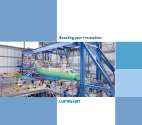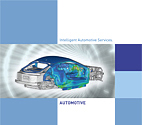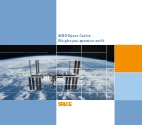Technical calculations
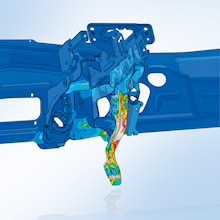
Increasing demands on new products in terms of functionality, quality, costs and development time can only be met by employing the latest in CAE methods on powerful computers.
Mastering a wide range of methods is essential for virtual product development. We can support you in this respect with over 30 years of experience and expertise. On request, we run tests on our own premises in addition to our calculation services.
We also offer you independent development of components in cooperation with our various specialist departments.
Our forte lies in analysing and providing solutions for complex tasks employing state-of-the-art methods. The primary aim is always to improve the quality of your products, reduce costs and shorten development time. We use a variety of standard CAE tools for our simulations.
Our service portfolio
- CAD design, FE modelling
- Strength analysis, joining techniques
- Structural component strength/random fatigue tests
- Structure optimisation
- Oscillation, vibration
- Non-linear structural dynamics, shock, fluid-structure interaction
- Flow analysis, temperature fields
- Method development, software development
Fields of application
- Automotive
- Aerospace
- Rail vehicles
- Defence engineering
- Materials-handling technology
- Production technology
- Plant construction
- Wind power
Fatigue Strength Assessment
Ever shorter development times mean that computer-based fatigue strength evaluation and the synergy of testing and simulation are gaining increasingly in importance.
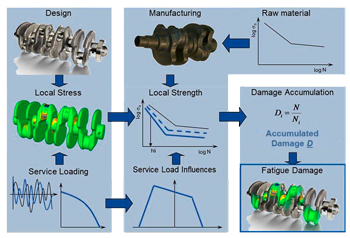
The service portfolio of IABG for fatigue strength testing includes the following:
- Computer-based fatigue strength assessment and Fatigue life – method development
- Materials specimen testing in the accredited IABG Fatigue Strength Testing Laboratory (IFL)
- Parts and components tests
Computer-based fatigue strength assessment
Computer-based fatigue strength assessment is divided essentially into three areas:
- Determination of local service stress (static, cyclic, dynamic, stochastic)
- Determination of local strength taking into account technological effects (forging, casting) and the influence of service loads (e.g. mean and residual stress)
- Damage accumulation
In addition to the standard FE solvers (ABAQUSTM, NASTRANTM, etc.) for calculating local services stresses, modern tools are used for calculating manufacturing processes (e.g. shaping, mechanical surface work hardening) and for fatigue life assessment (FEMFATTM, N-CodeTM, etc.). Alongside classic components and applications, another focal point is the analysis of structures subjected to vibrational excitation (earthquake loading, roadway surface excitation, and the like). Furthermore, analytical fatigue strength evaluations are made in compliance with the relevant guidelines (FKM, EuroCode, etc.) or according to customer-specific regulations.
Fatigue life – method development
New approaches, calculation methods and procedures are being developed for fatigue strength calculations. Such developments enable continuous improvements of the accuracy of simulation-based fatigue life assessments. Based on the results of extensive testing, new fatigue data are generated, for example, to describe local fatigue strength behaviour depending on the local manufacturing states (solidification process, local plastic deformation, etc.) and loading parameters (supporting effect, mean and residual stress, etc.). Commissioned industrial research work is another field:
- Damage-tolerant design
- Technological influences on local fatigue strength (casting, forging, surface work hardening, etc.).
- Damage accumulation
- Fracture mechanics methods
- Multiaxial fatigue etc.
CAD Design, FE Modelling
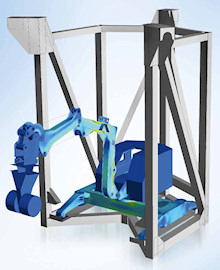
We produce designs according to your specifications or modify analysed designs based on calculation results. We employ parametric 3D CAD systems to enable quick and flexible change of geometries.
Conclusive calculation results require appropriate FE models that are matched to your particular specifications and conditions. In the modelling process, standard-format 2D and 3D CAD geometries are imported. The data is corrected and prepared for networking. Depending on the application we use bar models, shell models or volume models with automatic tetrahedron or hexahedron networking.
Software used
- Catia V5, Pro/E
- Medina, ANSA, HyperMesh, MSC.Patran, RStab
Fatigue Strength Analysis, Joining Techniques
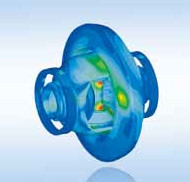
We examine the structural properties of your designs and connections using linear and non-linear FEM as well as analytical methods. Based on the results we make proposals for specific improvements. We perform computerised strength analyses in compliance with all the current standards and guidelines. In cooperation with our test departments, we provide planning and execution of tests for validating and determining load data and material parameters, for example.
Software used
MSC.Nastran, MSC.Marc, ANSYS, Abaqus, MDesign, Hexagon
Caption: Strength analysis of a differential cage
Method Development, Software Development
We have extensive experience in developing methods ranging from the elaboration of concepts and solutions to the development of specific procedures and algorithms through to the implementation and application of software tools. We frequently employ these methods to simplify and/or automate complex and time-consuming procedures. We also provide user-friendly interfaces to make application that much simpler for our customers.
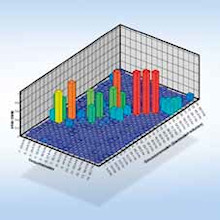
Our service portfolio
- Automatic analysis of screwed and riveted joints
- Fatigue life assessment of components using random excitation (e.g. rough road track) based on PSD
- Automatic modelling of bearings for gearboxes
- Combined calculations, e.g. FE and MBS, CFD and FE, FE optimisation and fatigue life analysis
- Development of powerful pre- and post-processors
Software used
Fortran, Java, C++, Script languages (Python, APDL, etc.)
Non-Linear Structural Dynamics, Shock, Fluid-Structure Interaction
Our experience with highly dynamic loaded components, complete systems for all sorts of vehicles as well as for stationary objects provides you with benefits in the following areas:
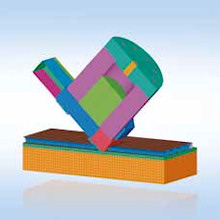
- Large-scale deformation, fracture and post-fracture behaviour
- Plasticity and stabilisation as a function of the strain rate
- Inhomogeneity and anisotropy of stiffness (fibre composite material)
- Rubber-elastic behaviour (elastomers)
- Fluid-structure interaction in the case of detonations
- Propagation of stress waves
Our service portfolio
- Safety analyses with regard to deformation, failure and shock
- Crash safety for vehicles and transport containers (e.g. CASTOR casks)
- Simulation of the opening behaviour of convertible tops
- Simulation of penetration processes, e.g. turbine blade impacting turbine housing
- Pyroshock loading of aerospace structures
- Pre- and post-shot analyses of underwater explosions including computer support for tests
- Analysis of stability and vulnerability of ships, submarines and other underwater vehicles
Software used
DYSMAS, DYNA3D, Abaqus, ANSYS, PAMCRASH
Structure Optimisation
Ever increasing demands for lightweight components require the use of CAE methods early on in the development stage to optimise component geometry. In the process, we perform optimisation analyses with static and dynamic load cases. Here, we can take into account restrictions such as stiffness requirements as well as manufacturing constraints. The conditions that apply to the subsequent manufacturing process thus become part of the optimisation.
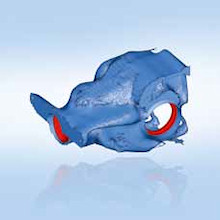
We provide the following range of services for improving your component structure:
- Topology optimisation to determine the ideal component shape based on the available space
- Implementation of the optimum shape in a CAD model
- Shape optimisation to further improve stress distribution at transition points
- Numerical optimisation of space and wall strength with parameterised concept models
- Predictions about the functional feasibility of a new development and dimensioning of an optimum structure
Software used
TOSCA, Optistruct, MSC.Nastran
Oscillation, Vibration
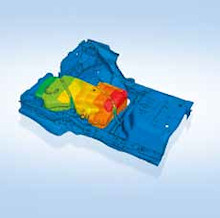
Our service portfolio ranges from modal analysis to response analysis through to transient dynamic calculation and earthquake simulation.
A validated FE model is required for quantitative prediction of vibration properties. We create these models based on measured dynamic properties or we rework existing models. The objective is to achieve the best possible match between the eigenfrequencies and natural modes based on experiments and simulation. This model update can be achieved manually or by using numerical optimisation methods.
Software used
MSC.Nastran, ANSYS, Abaqus
Fluid Simulations (CFD)
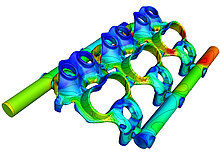
Fluid flow phenomena play an important role in many engineering applications. In all of our key business areas, including the aero-space, automotive, energy and the defence industry, aerodynamic and thermodynamic problems often play a critical role for the functionality and efficiency of machines and systems.
It is often difficult, if at all, to examine fluid flows by experimental means, and it often requires significant engineering and planning efforts. Computational Fluid Dynamics (CFD) offers an attractive alternative.
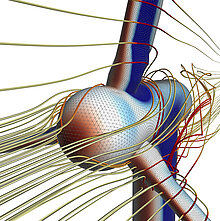
Applications
- Computer-Aided Design: to determine critical and complex design parameters, e.g. temperature distribution, fluxes, aerodynamic loads, mixing behaviour, particle dispersion
- Design optimisation: to investigate the optimisation potential of systems
- Troubleshooting: to identify sources of errors and to develop engineering solutions
Typical engineering problems
- Heat transfer phenomena (heat transport, radiation, convection)
- Aerodynamic loads on structures (e.g. for wind turbines)
- Atmospheric wind flows
- Building climatisation, HVAC (heating, ventilation, air conditioning)
- Pressure loss calculation
- Aerodynamics of vehicles and buildings
- Pollutant concentration and dispersion (work safety)
- Fire and smoke spread analysis
- Explosion processes in air and under water
Your advantage
- Turn-key solutions: we support our customers during the entire project, from the definition of the engineering problem to the development of a tailored CFD solution.
- Team of experts: our team comprises experts of fluid mechanics, thermodynamics and structure dynamics with extensive experience in numerical simulations.
- Optimised Tools: depending on the type of problem to be solved, we employ the established commercial simulation package ANSYS CFX or the innovative open-source package OpenFOAM. For some specific topics, we also use dedicated solvers such as Fire Dynamics Simulator (FDS) from NIST and our in-house solver DYSMAS. We perform all of our calculations on our in-house state-of-the-art computer cluster.
- DIN EN ISO/IEC 27001:2017
- VDA ISA TISAX zertifiziert für die Labels „Informationen mit sehr hohem Schutzbedarf“, „Prototypenschutz“ und „Datenschutz“ für die Standorte Ottobrunn und Lichtenau
- ISO 45001 (Locations Ottobrunn, Lichtenau)
- ISO 14001
- Verzeichnis der Prüfverfahren – Prüflaboratorium DIN EN ISO/IEC 17025 (Standort Lichtenau)
- BSI TR-03140 (TR-SatDS1G) Conformity assessment according to the sateLlite data security act
- ISO 9001
- DIN EN ISO/IEC 17025 for Fatigue Strength Laboratory
- DIN EN ISO/IEC 17025 für das Betriebsfestigkeitslabor - Verzeichnis der Prüfverfahren
- EN 9100
- Accreditation Calibration Lab for Mechanical Units according to DIN EN ISO/IEC 17025
- Accreditation of Testing Lab for Qualification Tests (PLQ) according to DIN EN ISO/IEC 17025
- Certification of Space Test Centre according to ECSS-Q-20-ST-07C
- BSI-certified IT security provider
- AEO (Authorised Economic Operator)
